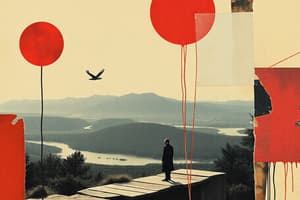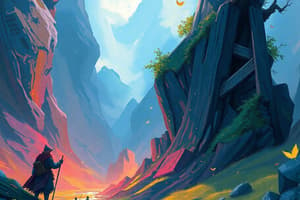Podcast
Questions and Answers
What is the primary purpose of color blocking in painting?
What is the primary purpose of color blocking in painting?
- To apply paint onto a dry surface
- To blend colors smoothly
- To create strong visual contrasts (correct)
- To add texture with dry brushes
What is the primary effect achieved by using glazing in painting techniques?
What is the primary effect achieved by using glazing in painting techniques?
- Creating dynamic splashing effects
- Creating surface texture
- Enhancing depth and luminosity (correct)
- Applying solid blocks of color
Which painting technique involves the use of thick application of paint that stands out from the surface?
Which painting technique involves the use of thick application of paint that stands out from the surface?
- Glazing
- Scumbling
- Impasto (correct)
- Wet-on-Wet
What technique in drawing uses intersecting lines to create texture and shading?
What technique in drawing uses intersecting lines to create texture and shading?
Which application method involves using a minimal amount of paint on a dry brush?
Which application method involves using a minimal amount of paint on a dry brush?
Which technique involves creating shading by using parallel lines?
Which technique involves creating shading by using parallel lines?
What is scumbling in painting techniques?
What is scumbling in painting techniques?
Which of the following does NOT belong to special effects in painting?
Which of the following does NOT belong to special effects in painting?
What defines the concept of 'medium' in art?
What defines the concept of 'medium' in art?
Which medium is known for its quick drying time and popularity among beginners?
Which medium is known for its quick drying time and popularity among beginners?
Which characteristic is NOT associated with oil painting?
Which characteristic is NOT associated with oil painting?
Which medium is best suited for creating soft transitions between colors in landscape art?
Which medium is best suited for creating soft transitions between colors in landscape art?
What unique feature do pastels possess compared to other painting mediums?
What unique feature do pastels possess compared to other painting mediums?
What does Marshall McLuhan's statement 'The medium is the message' emphasize?
What does Marshall McLuhan's statement 'The medium is the message' emphasize?
Which type of pastel is NOT mentioned in the content?
Which type of pastel is NOT mentioned in the content?
What is a common characteristic of acrylic paint compared to oil paint?
What is a common characteristic of acrylic paint compared to oil paint?
What is the primary binder used in oil pastels?
What is the primary binder used in oil pastels?
Which painting medium is specifically associated with the use of a heat gun?
Which painting medium is specifically associated with the use of a heat gun?
What distinguishes gouache painting from watercolor painting?
What distinguishes gouache painting from watercolor painting?
Which of the following painting mediums involves pigments bound within an emulsion?
Which of the following painting mediums involves pigments bound within an emulsion?
During which historical period was fresco painting predominantly used?
During which historical period was fresco painting predominantly used?
What is a defining feature of sumi-e ink painting?
What is a defining feature of sumi-e ink painting?
Which painting medium leverages digital technology for creation?
Which painting medium leverages digital technology for creation?
What does the term 'technique' specifically describe in art?
What does the term 'technique' specifically describe in art?
What is a primary technique used in digital painting to enhance images?
What is a primary technique used in digital painting to enhance images?
Which technique involves changing how colors interact in digital art?
Which technique involves changing how colors interact in digital art?
What is a characteristic feature of 3D modeling in digital art?
What is a characteristic feature of 3D modeling in digital art?
Which of the following best describes the technique of collage?
Which of the following best describes the technique of collage?
What is one way photo manipulation can enhance an image?
What is one way photo manipulation can enhance an image?
What technique involves using tools or fingers to blur lines and create softer transitions?
What technique involves using tools or fingers to blur lines and create softer transitions?
In mixed media techniques, what is the purpose of adding textural effects?
In mixed media techniques, what is the purpose of adding textural effects?
Which type of carving removes material from a solid block to create a sculpture?
Which type of carving removes material from a solid block to create a sculpture?
What does the choice of medium and technique impact in artwork?
What does the choice of medium and technique impact in artwork?
In printmaking, which technique involves carving into a block of wood?
In printmaking, which technique involves carving into a block of wood?
Which approach is NOT typically associated with digital sculpting?
Which approach is NOT typically associated with digital sculpting?
What is the purpose of using scratching as a textural technique?
What is the purpose of using scratching as a textural technique?
Which of the following is a characteristic of additive modeling?
Which of the following is a characteristic of additive modeling?
How does intaglio printing differ from relief printing?
How does intaglio printing differ from relief printing?
What is the primary function of an eraser in artistic techniques?
What is the primary function of an eraser in artistic techniques?
What does the technique of relief printing commonly involve?
What does the technique of relief printing commonly involve?
Flashcards are hidden until you start studying
Study Notes
Techniques in Art
- Painting Techniques: Artists use various techniques to apply paint to a surface, influencing texture, appearance, and effect.
- Brushwork:
- Glazing: Applying transparent paint layers to create depth and luminosity.
- Impasto: Thick textured application of paint that stands out from the surface.
- Scumbling: Rubbing a paint layer over a dry layer to create texture and highlights.
- Colour Techniques:
- Color Blocking: Using large solid color areas for strong visual contrasts.
- Color Mixing: Combining colours to create new hues & shades.
- Application Methods:
- Wet-on-Wet: Applying paint onto a wet surface to allow color blending.
- Dry Brush: Using a dry brush with minimal paint for a scratchy, textured effect.
- Special Effects:
- Splattering: Flicking or splashing paint onto the canvas for dynamic effects.
- Dripping: Allowing paint to drip down the canvas (often used in Abstract Expressionism).
Drawing Techniques
- Line Techniques: Artists use various methods to create marks or lines on a surface to represent forms, textures, and details in a drawing.
- Cross-Hatching: Created shading and texture using intersecting lines.
- Hatching: Using parallel lines to build up shading.
- Stippling: Using dots to create texture and shading.
Mediums and Techniques of Art
-
Medium: Refers to the materials used by artists to create a work of art. The material chosen by artists influences the overall message and aesthetic of their work.
- Oil Painting: One of the oldest painting mediums. Dries slowly, yielding a deep, rich color with a distinctive smell.
- Watercolor Painting: Soft, transparent appearance and takes a long time to dry. Primarily used by landscape painters.
- Acrylic Painting: Dries quickly, suitable for fast-working artists. Popular with beginners due to its low price and ease of use.
- Pastels: Dry, powdered pigment held together with a binder. Two types: oil pastels and soft pastels.
- Tempera: Pigments are bound in a water-soluble emulsion (like water and egg yolk) or oil-in-water emulsion (oil and egg).
- Encaustic: Made from beeswax and color pigments. Requires a heat gun or heating element.
- Fresco: One of the three main painting mediums used during the Renaissance. Used to adorn ceilings and walls of churches and public buildings.
- Ink Painting: Simplicity and minimalism are key. Emphasizes the beauty of the line and smooth flow of the ink.
- Gouache Painting: Related to watercolor but uses a thicker pigment.
- Digital Painting: Uses digital devices like iPads, computers, and tablets to create paintings. Offers convenient features, such as modifying brushes to imitate conventional mediums.
-
Technique: Refers to the process an artist uses to manipulate their chosen medium.
- Shading Techniques:
- Blending: Smooth transition between light & dark areas using blending stumps or fingers.
- Smudging: Bluring lines and creating softer transitions (using tools or fingers).
- Textural Techniques:
- Scratching: Creating images or textures by scratching away a top layer of material (paint or ink).
- Erasing: Using an eraser to lift out highlights or correct mistakes.
- Shading Techniques:
Sculpture Techniques
- Artists use various methods to shape and manipulate materials to create three-dimensional forms.
- Carving:
- Subtractive Carving: Removing material (like stone or wood) to create a sculpture.
- Relief Carving: Designs are carved into a flat surface where the image is raised above the background.
- Modeling:
- Additive Modeling: Building up material (like clay) to create a form.
- Casting: Pouring liquid material (like bronze or resin) into a mold to create a solid form.
Printmaking Techniques
- Methods used to create artwork by transferring ink from a matrix (plate, block, or screen) to a surface.
- Relief Printing:
- Woodcut: Carving into a block of wood, inking the surface, and pressing it onto paper.
- Linocut: Similar to woodcut but using linoleum.
- Intaglio Printing:
- Etching: Creating detailed images on a metal plate, inking, and printing onto paper.
- Engraving: Carving directly into a metal plate to create an image.
- Relief Printing:
Digital Art Techniques
- Using electronic tools and software to create or manipulate visual art.
- Digital Painting:
- Layering: Building up complex images and effects using multiple layers.
- Blending Modes: Adjusting how colors and textures interact through layer modes.
- 3D Modeling:
- Mesh Modeling: Creating 3D objects by manipulating a network of points and lines (vertices and edges).
- Digital Sculpting: Shaping digital “clay” to create detailed 3D models.
- Photo Manipulation:
- Layer Masks: Hiding/revealing parts of layers to create composite images.
- Adjusting Layers: Applying changes (non-destructive) to color and tone.
- Digital Painting:
Mixed Media Techniques
- Combining materials and methods.
- Collage: Combining various materials (like paper or fabric) to create a single artwork.
- Textural Effects: Incorporating materials like sand or fabric to create physical textures in paintings or drawings.
Studying That Suits You
Use AI to generate personalized quizzes and flashcards to suit your learning preferences.




